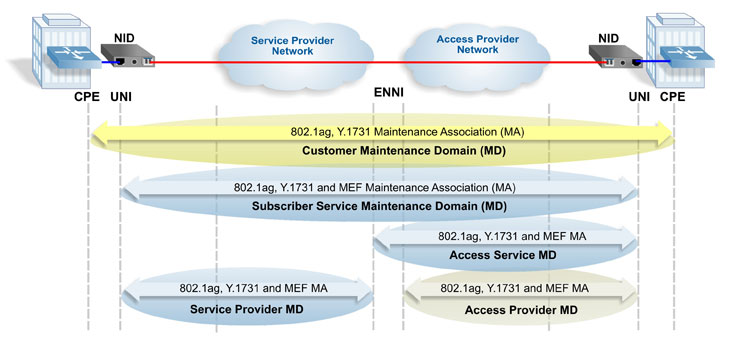Providing reliable Ethernet services and supporting enforceable SLA assurances requires Operations Administration and Maintenance (OAM) functions to provide fault management and performance monitoring of the entire Ethernet connection.
ITU-T Y.1731 and IEEE 802.1ag standards enable End-to-End Service OAM functions to accomplish these service delivery objectives across one or more carrier networks. 802.1ag Connectivity Fault Management (CFM) improves reliability with OAM tools for instant fault notification and rapid fault isolation. ITU-T Y.1731 monitors the performance of Ethernet services on both an Ethernet Virtual Connection (EVC) and Class of Service basis for Service Level Agreement (SLA) assurance.
End-to-End Service OAM spans the entire Ethernet service between demarcation points at each customer location (UNI to UNI). The UNI is the User-to-Network Interface that defines an Ethernet service demarcation point (physical port) between customer and service provider. The Network Interface Device provides the UNI, and the OAM Intelligence that is required at the Customer Premises for End-to-End Service OAM.
This wholesale Ethernet (out-of-franchise) application illustrates an E-Line service between two customer locations that geographically spans two or more networks. The Service Provider is responsible for the billing and service contract. The Access Provider enables connectivity to the customer location for the Service Provider, and delivers the access service plus SLA assurance to the Service Provider.

iConverter NIDs are installed at each subscriber location, which enable Service OAM capabilities. NIDs the support the 802.1ag and Y.1731 Service OAM standards constantly monitor the end-to-end service performance of the network, and the Service Provider has visibility across the Access Provider’s network for assurance that the contracted Service Level Agreement expectations are being met.
One of the important benefits of 802.1ag and Y.1731 is their ability to support multiple domain levels (shown as ovals in the diagram). A domain level can be thought of as a viewpoint, or perspective, of different stakeholders in an Ethernet service. Maintenance Domains are abstract concepts that break the maintenance of Ethernet services into different levels. These levels make it easy to delineate the responsibilities and perspectives of the different stakeholders. Maintenance Associations (shown as arrows) are the physical network paths that reside in each domain. Maintenance Points (shown as vertical dotted lines) are network elements along the Maintenance Associations.
Download the End-to-End Service OAM white paper to learn more
The Subscriber domain traverses the entire length of the service from the Customer Equipment at one location to Customer Equipment at the other location (shown in yellow). The Service Provider has set up three Maintenance Domains (shown in blue). The Subscriber Service Maintenance Domain spans from UNI to UNI, and monitors the availability and performance of the end-to-end service to ensure the SLA assurance to the Subscriber is being met. The Access Service Maintenance Domain monitors the Access Provider’s service, and the Service Provider Maintenance Domain monitors the EVC across the Service Provider’s own network. The Access Provider’s Maintenance Domain (shown in beige) monitors the EVC from the ENNI to the remote subscriber to ensure the access network is performing as contracted to the Service Provider.
IEEE 802.1ag Connectivity Fault Management
iConverter NIDs support the IEEE 802.1ag Connectivity Fault Management (CFM) for scalable, continuous fault monitoring of Ethernet services for the Subscriber, the Service Provider and the Access Provider; each operating at a different network domain level. Key CFM features include:
- Continuity Check – A periodical keep-alive message exchanged between end-points of an Ethernet service in a domain level that provides proactive fault monitoring and automatic notification
- Link Trace – An Administrator-initiated command for rapid fault isolation that traces intermediate points from one end-point to another end-point of an Ethernet service
- Loop Back – An Administrator-initiated command for an end-point to request response from an intermediate point or another end-point of an Ethernet service
ITU-T Y.1731 Performance Monitoring
iConverter NIDs support ITU-T Y.1731 Performance Monitoring to ensure continuous SLA compliance. Key SLA parameters include:
- Frame Delay – The amount of time it takes a frame to travel from one end-point to another end-point of an Ethernet service
- Frame Delay Variation (Jitter) – The statistical difference in the collection of Frame Delay readings between the end-points
- Frame Loss – The number of frames lost between the end-points of an Ethernet service
- Availability - The percentage of the time the service is operational










